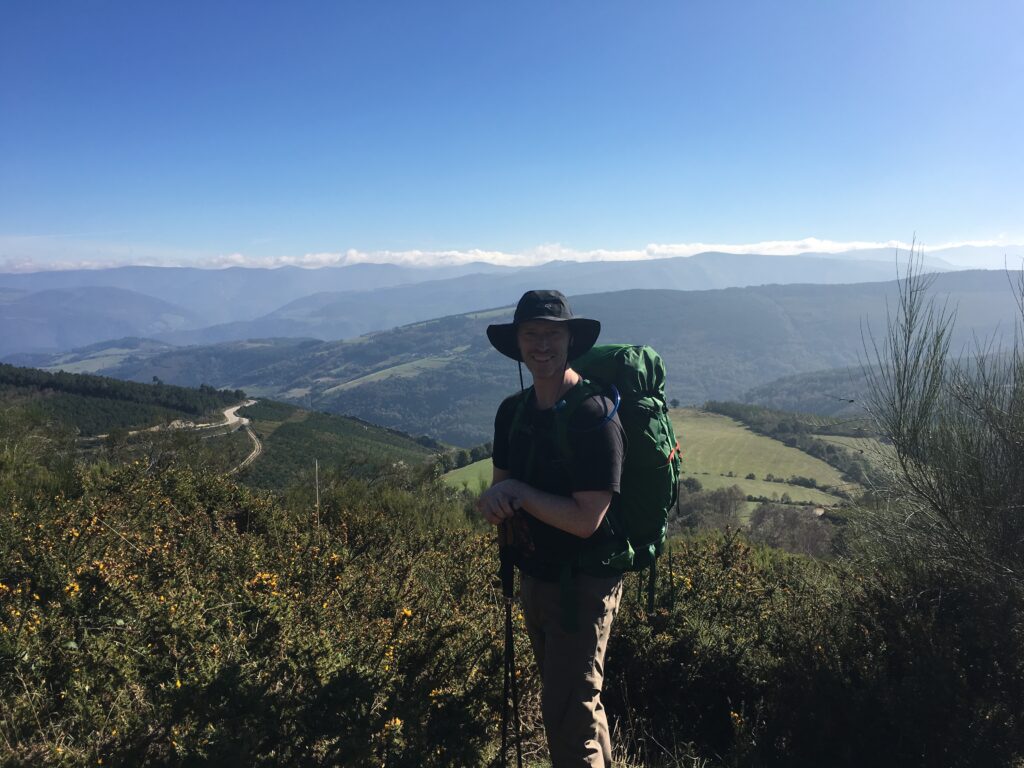
Walking the Walk: Understanding Pilgrimage via a Walking Journal
 In the fall of 2018, I travelled to northern Spain and walked a 340 km stretch of the Camino de Santiago pilgrimage route, the ancient Camino Primitivo. At the time, I was on sabbatical, and I wasn’t planning on walking the whole route, but circumstances conspired to propel me on a two-week trek from the medieval town of Oviedo in Asturias to the city of Santiago di Compostela in the Galicia region and the shrine of St. James. As unprepared as I was, my experience on “the way” was both mundane and sublime. Following various signs and markers, I was guided along paths a thousand years old, over snow dotted mountains, through stony villages warm with hospitality, and across rickety bridges that spanned quick running streams. I remember, before setting out a friend said to me that the strangest thing about doing the Camino is that your job every day is simply to walk—not at all the usual multitasking chaos of Western life. Like many, on the trail I discovered the joy of new connections, both to fellow travelers and to the earth slowly passing beneath our feet. Communitas involved swapping stories, getting lost and finding our way, noticing things both strange and familiar, and lingering in the simplicity of a moment as if the act of walking was wiping away the past and setting us on a slow march into the future.
In the fall of 2018, I travelled to northern Spain and walked a 340 km stretch of the Camino de Santiago pilgrimage route, the ancient Camino Primitivo. At the time, I was on sabbatical, and I wasn’t planning on walking the whole route, but circumstances conspired to propel me on a two-week trek from the medieval town of Oviedo in Asturias to the city of Santiago di Compostela in the Galicia region and the shrine of St. James. As unprepared as I was, my experience on “the way” was both mundane and sublime. Following various signs and markers, I was guided along paths a thousand years old, over snow dotted mountains, through stony villages warm with hospitality, and across rickety bridges that spanned quick running streams. I remember, before setting out a friend said to me that the strangest thing about doing the Camino is that your job every day is simply to walk—not at all the usual multitasking chaos of Western life. Like many, on the trail I discovered the joy of new connections, both to fellow travelers and to the earth slowly passing beneath our feet. Communitas involved swapping stories, getting lost and finding our way, noticing things both strange and familiar, and lingering in the simplicity of a moment as if the act of walking was wiping away the past and setting us on a slow march into the future.
Like many of my sabbatical projects, I worked my experience on the Camino into the development of material for teaching—in this case, a course on contemporary and traditional pilgrimage practices. And so, upon my return, I taught a fourth-level seminar course specifically designed to explore themes and issues associated with contemporary pilgrimage practices with my students. Because of the experiential dimension of pilgrimage as a physical action—and because of my own experience in this regard—I asked my students to keep a “walking journal” throughout the course. My intention was to open for the students a more physical, experiential component to balance the conventional, rather more abstract, and possibly less accessible scholarship on pilgrimage. I was hoping that the act of walking in this intentional way would provide unexpected connections and open ways of understanding the tradition and practice of pilgrimage not immediately obvious from their readings. I asked my students to walk 10 km a week and to keep a regular journal about this experience. While they looked at me strangely at the thought of walking that much each week, they set about the task with reasonably good humour.
Fitting 10 km of walking into busy schedules proved to be a challenge. For some students, it was a matter of taking a long walk on a Saturday morning. For others it involved laps of their apartment or a series of meandering detours through town. Equally varied were their reflections. Their journals captured the surprising significance of their walking experiences: some described the walking as exploratory, taking them to locations they had never been before; others spoke of the physical sensation of walking and the growing importance of this weekly ritual and the comfort it brought during the first days of the pandemic lockdown; still others spoke of the way walking had become an important means of processing their experiences, to slow down, reflect, and take note of what they were dealing with, or the way their bodies had taken on the hectic nature of their lives. From the students’ feedback, the walking journals were clearly locations of significant learning in the course. As one student put it:
One of the assignments for this class was a walking journal: we were to walk 10 km a week and keep a journal describing the experience. The assignment was surprisingly challenging but so rewarding! To get my whole self—body, mind, emotions—involved in a class assignment was unusual, but had an enormous impact on my learning. All of us in the class found that, though our approaches to the journal and what we took away from it were diverse, the walking journal deepened our learning and gave us a much fuller understanding of how pilgrimage works and why one might undertake it.
For my part, it fascinates me that the students will likely remember what they learned from walking far longer than from any reading list I set. Moreover, I found that I learned much from their experience. For one thing, it was clear that my own perspective on Christian practice needed to be connected with ordinary and mundane experience—and not expect that the exotic environs of northern Spain would be the only locus of transformation. The power of walking is that in its pervasiveness it connects so much of one’s person, holding together experiences both commonplace and extraordinary. Within that unexpected mix, it allows for the kind of boundary-breaking moment that invites insight and creative inspiration. Walking is physical; it promotes solitude and reflection; it slows one down to a single moment; it can be an occasion of companionship; it traverses a specific terrain; it can involve searching as well as finding; it embraces encounter. I had hoped that walking would afford my students a different perspective on pilgrimage. I had not anticipated just how effective this would be. There seems to be no substitute for experience as a teacher, and for the simplicity of walking as a way of connecting to something as theologically elegant and seemingly far removed from the everyday as the tradition of Christian pilgrimage.
Leave a Reply